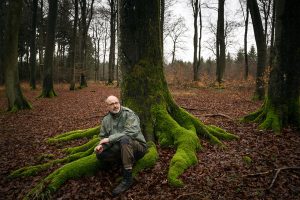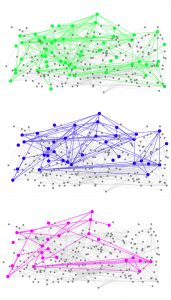 Lab Director, Noshir Contractor, participated in the closing panel, “Reflections: Lessons learned,” for the 22nd Annual Organization Science Winter Conference: Innovations & Organizations on February 7th, 2016, alongside Natalya Vinokurova (Wharton), Todd Zenger (University of Utah), Martin Schulz (British Columbia at Vancouver).
Lab Director, Noshir Contractor, participated in the closing panel, “Reflections: Lessons learned,” for the 22nd Annual Organization Science Winter Conference: Innovations & Organizations on February 7th, 2016, alongside Natalya Vinokurova (Wharton), Todd Zenger (University of Utah), Martin Schulz (British Columbia at Vancouver).
“German Forest Ranger Finds That Trees Have Social Networks, Too”

A recent New York Times article by Sally McGrane discusses the ecology put forth by German forester Peter Wohlleben in his recent book The Hidden Life of Trees: What They Feel, How They Communicate — Discoveries From a Secret World. Wohlleben’s writing is marked by the use of emotive language – e.g. “trees suckle their children” – to discuss the relationships of forest flora. His style of writing may be evocative, but Wholleben’s ideas are not novel. The book popularizes what environmental scientists have know for some time – that trees negotiate cohabitation through a system of chemicals, roots, and symbiotes that constitute what Wholleben terms the “wood wide web”. Paying attention to these networks might help us change the way we manage forests as a natural resource. Wholleben also hopes it will affect the way conceptualize nature in general if we see the complex communities of individuals rather than stands of ‘oxygen producing robots.’
Read the full article here: http://mobile.nytimes.com/2016/01/30/world/europe/german-forest-ranger-finds-that-trees-have-social-networks-too.html?hp&action=click&pgtype=Homepage&clickSource=story-heading&module=photo-spot-region®ion=top-news&WT.nav=top-news&_r=1&referer
SONIC Speaker Series Presents: Charles Macal
SONIC Lab is proud to welcome Charles Macal who will present a talk on Tuesday, February 23rd, 2016 at 10:00 AM in Frances Searle Building, Room 1-483. All are welcome to attend. To schedule a one-on-one meeting with Dr. Macal please schedule a time HERE. Please contact Meghan McCarter with any questions or comments.

Simulating Chicago (and Everyone in It)
Abstract
chiSIM, the Chicago Social Interaction Model, is an agent-based model of people and places in Chicago along with the daily activities in which residents engage. To support planning and policy making, chiSIM models the behaviors and social interactions of all Chicago residents, represented in the model at the individual level. Places consist of geo-located parcels in the city, such as households, schools, workplaces, hospitals, and general quarters, such as nursing homes, dormitories, jails, etc. During the course of a simulated day, agents move from place to place, hour by hour, engaging in social activities and interactions with co-located agents. Examples of applications for this model include forecasting socially mediated processes, such as the spread of infectious diseases and the adoption of new technologies; measuring the potential effectiveness of public health and social programs and interventions; and assessing population-wide energy usage.
Biography
Charles Macal, PhD, PE, is Senior Systems Engineer, Argonne Distinguished Fellow, and Group Leader of the Social & Behavioral Systems Group within the Global Security Sciences Division of Argonne National Laboratory. Dr. Macal is recognized globally as a leader in the field of agent-based modeling and simulation and has led interdisciplinary research teams in developing innovative computer simulation models in application areas including global and regional energy markets, critical materials, electric power, healthcare and infectious diseases, environment and sustainability, and technology adoption. Dr. Macal holds Senior Fellow appointments at the Computation Institute (CI) of the University of Chicago and the Northwestern-Argonne Institute for Science and Engineering (NAISE). He received a Ph.D. in Industrial Engineering & Management Sciences from Northwestern University and holds an M.S. in Industrial Engineering and a B.S. in Engineering Sciences from Purdue University.
Stream the full presentation here:
“Online social networks do not change the fundamentals of friendship”
 In a paper released in Royal Society Open Science, Robin Dunbar, a psychologist at Oxford University talks about the number of social relationships an individual can maintain. Known as the Dunbar’s number, 150 is the number of people an individual can maintain relationships with. Then the question of whether modern social media changes that number needs to be addressed. Dunbar surveyed 2,000 people (first national scale random sample study) of regular social media users and 1375 adults who may or may not use Facebook. Studies prove Dunbar’s number. Other numbers that came out of this testing was most people had 5 friends who they could turn for an emergency and 15 friends they call close friends. It gives more evidence to the theory that there is a cognitive limit on how much the brain can handle, despite Facebook’s ability to expand the network.
In a paper released in Royal Society Open Science, Robin Dunbar, a psychologist at Oxford University talks about the number of social relationships an individual can maintain. Known as the Dunbar’s number, 150 is the number of people an individual can maintain relationships with. Then the question of whether modern social media changes that number needs to be addressed. Dunbar surveyed 2,000 people (first national scale random sample study) of regular social media users and 1375 adults who may or may not use Facebook. Studies prove Dunbar’s number. Other numbers that came out of this testing was most people had 5 friends who they could turn for an emergency and 15 friends they call close friends. It gives more evidence to the theory that there is a cognitive limit on how much the brain can handle, despite Facebook’s ability to expand the network.
Read the full article here: http://www.economist.com/news/science-and-technology/21688846-online-social-networks-do-not-change-fundamentals-friendship-done-bar
Noshir presents “Leveraging Network Science to Address Grand Societal Challenges” at University of Michigan
 Lab Director Noshir Contractor presented his lecture “Leveraging Network Science to Address Grand Societal Challenges” on Jan. 15th, 2016 at the University of Michigan, Ann Arbor, sponsored jointly by the Interdisciplinary Committee on Organizational Studies (ICOS) and the Digital Future Lecture Series. Using examples of his research in the area of networks, Noshir illustrated how Network Science is fundamental to unleashing the intellectual insights locked in big data. Specifically, he discussed how these insights offer social scientists in general, and social network scholars in particular, an unprecedented opportunity to engage more actively in monitoring, anticipating and designing interventions to address grand societal challenges.
Lab Director Noshir Contractor presented his lecture “Leveraging Network Science to Address Grand Societal Challenges” on Jan. 15th, 2016 at the University of Michigan, Ann Arbor, sponsored jointly by the Interdisciplinary Committee on Organizational Studies (ICOS) and the Digital Future Lecture Series. Using examples of his research in the area of networks, Noshir illustrated how Network Science is fundamental to unleashing the intellectual insights locked in big data. Specifically, he discussed how these insights offer social scientists in general, and social network scholars in particular, an unprecedented opportunity to engage more actively in monitoring, anticipating and designing interventions to address grand societal challenges.
“Social networks as important as exercise and diet across the span of our lives”
 The more social ties people have at an early age, the better their health is at the beginnings and ends of their lives, according to a new study from the University of North Carolina at Chapel Hill. The study is the first to definitively link social relationships with concrete measures of physical wellbeing such as abdominal obesity, inflammation, and high blood pressure, all of which can lead to long-term health problems, including heart disease, stroke and cancer.
The more social ties people have at an early age, the better their health is at the beginnings and ends of their lives, according to a new study from the University of North Carolina at Chapel Hill. The study is the first to definitively link social relationships with concrete measures of physical wellbeing such as abdominal obesity, inflammation, and high blood pressure, all of which can lead to long-term health problems, including heart disease, stroke and cancer.
Read the full article here: http://uncnews.unc.edu/2016/01/04/social-networks-as-important-as-exercise-and-diet-across-the-span-of-our-lives/
“Mapping cancer’s ‘social networks’ opens new approaches to treatment”
 Scientists at The Institute of Cancer Research(link is external), London, compared proteins inside cells to members of an enormous social network, mapping the ways they interact. This allowed them to predict which proteins will be most effectively targeted with drugs.The team found that there are many molecular pathways that interact to affect the development of cancer. Cancer-causing proteins that have already been successfully targeted with drugs tended to have particular ‘social’ characteristics that differ from non-cancer proteins.
Scientists at The Institute of Cancer Research(link is external), London, compared proteins inside cells to members of an enormous social network, mapping the ways they interact. This allowed them to predict which proteins will be most effectively targeted with drugs.The team found that there are many molecular pathways that interact to affect the development of cancer. Cancer-causing proteins that have already been successfully targeted with drugs tended to have particular ‘social’ characteristics that differ from non-cancer proteins.
Read the full article here: http://www.cancerresearchuk.org/about-us/cancer-news/press-release/2015-12-23-mapping-cancers-social-networks-opens-new-approaches-to-treatment
“Like air traffic, information flows through major neuron ‘hubs’ in the brain, IU scientists find”

This article published by Indiana University Bloomington describes a new study one of its researchers has published in the journal Neuroscience, drawing a close analogy between airline routes and the neuronal network in our brain.
Co-PI Suzanne Bell Profiled by Glamour Magazine
 Glamour Magazine profiles CREWS Grant collaborator Suzanne Bell and a number of other female professionals contributing to NASA’s upcoming Mars Mission in the article “Would You Go to Mars? Meet the Four Women Astronauts Who Can’t Wait to Go”. Read the full article here: http://www.glamour.com/inspired/2016/01/nasa-women-astronauts-first-trip-to-mars
Glamour Magazine profiles CREWS Grant collaborator Suzanne Bell and a number of other female professionals contributing to NASA’s upcoming Mars Mission in the article “Would You Go to Mars? Meet the Four Women Astronauts Who Can’t Wait to Go”. Read the full article here: http://www.glamour.com/inspired/2016/01/nasa-women-astronauts-first-trip-to-mars
“First, Let’s Get Rid of All the Bosses”
 Rodger D. Hodge of the New Republic reports on CEO Tony Hsieh’s recent decision to shift Zappo’s to the Evolutionary Teal style of management through Holacracy. This hotly discussed new approach discards static, hierarchical power structures for more distributed and plastic forms of leadership. As defined by Frederic Laloux in Reinventing Organizations, Evolutionary Teal organizations “trust in the abundance of life” and focus on self-actualization rather than material goals. This means something different to every organization and Zappo’s implementation came with a wave of controversial new policies. The sudden and radical switch was received with mixed reviews from within and without. The jury is still out on whether Hsieh’s move represents a meaningful reform or is simply another flash in the pan of the avant-garde corporate.
Rodger D. Hodge of the New Republic reports on CEO Tony Hsieh’s recent decision to shift Zappo’s to the Evolutionary Teal style of management through Holacracy. This hotly discussed new approach discards static, hierarchical power structures for more distributed and plastic forms of leadership. As defined by Frederic Laloux in Reinventing Organizations, Evolutionary Teal organizations “trust in the abundance of life” and focus on self-actualization rather than material goals. This means something different to every organization and Zappo’s implementation came with a wave of controversial new policies. The sudden and radical switch was received with mixed reviews from within and without. The jury is still out on whether Hsieh’s move represents a meaningful reform or is simply another flash in the pan of the avant-garde corporate.
Read the full article here: https://newrepublic.com/article/122965/can-billion-dollar-corporation-zappos-be-self-organized
